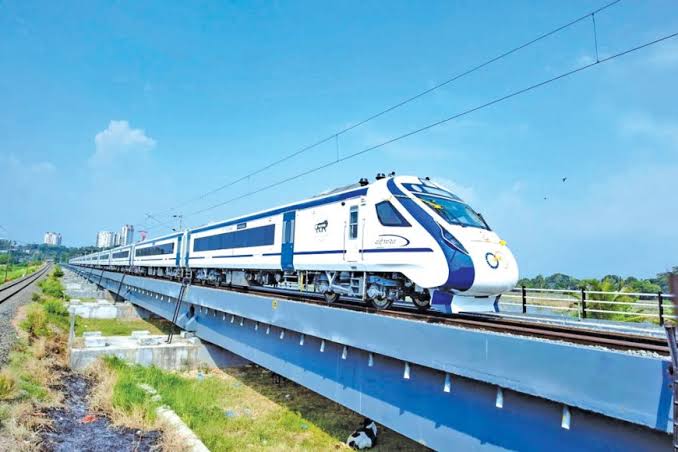
Indian Railways, the backbone of India's transport industry, is undergoing a revolutionizing process under the visionary agenda of the current government. The most recent milestone in the journey was that of Prime Minister Narendra Modi unveiling the new Pamban Bridge at Rameswaram, Tamil Nadu, on April 6, 2025. This engineering marvel, India's first vertical lift railway sea bridge, not just improves connectivity between Rameswaram Island and the mainland but also marks the future of Indian Railways—modern, efficient, and resilient.
The 2.08-kilometer-long Pamban Bridge is an Indian engineering marvel. It was built at a cost of over ₹550 crore, has a 72.5-meter-long vertical lift span which can be raised to 17 meters, and has the capability to accommodate huge ships passing underneath while ensuring unbroken train movement. This bridge has replaced the century-old British-era cantilever bridge, which was becoming increasingly difficult to maintain due to harsh marine conditions.
The inauguration of the Pamban Bridge is coinciding with the commencement of the Rameswaram-Tambaram Express, a new train connecting Rameswaram with Chennai on a daily basis. The move is part of an larger plan to expand access to pilgrimage and tourist hubs, cut distances between large cities, and promote economic activity in the area.
Indian Railways vision is not just about infrastructure improvement but revolutionizing the experience of the passenger. The government is interested in making rail travel cleaner, more comfortable, and quicker. Introducing Vande Bharat trains and the Bullet Train project is all part of this vision. Station improvement, digital ticketing, and security measures are being implemented as well.
Modernization Initiatives
Indian Railways is undertaking a number of projects to modernize its old infrastructure and improve the quality of service. The Railway Ministry has scheduled to invest ₹5,400,000 crore to modernize the railways by 2030. Modernization comprises 100% electrification of railways, improvement of existing lines with more comforts and increased speeds, increased new line extension, improvement of railway stations, inauguration and eventual creation of a vast network of high-speed trains connecting India's major cities in various regions, and construction of several dedicated freight corridors to reduce the cost of cargo across the country.
The Amrit Bharat Station Scheme is also an important scheme for the redevelopment of railway stations to offer passengers a modernized facility. The provision of Pradhan Mantri Bhartiya Janaushadhi Kendras (PMBJKs) at the stations to provide low-cost medicines is another aspect towards improving passenger amenities.
Indian Railways is also making efforts towards indigenization of technology to curb reliance on foreign technology and build self-reliance. It includes strengthening the Indigenous train protection system Kavach, upgradation of the production unit, workshops, and factories to make them more efficient and capable of carrying out domestic manufacturing of modern rolling stock and parts. In the National Hydrogen Mission, Indian Railways will roll out its first hydrogen train this year as part of a broader strategy towards efficiency and sustainability.
The 2025-26 Union Budget had provisioned ₹2.52 lakh crore for Indian Railways, a 3.9% hike from FY24. The budget would largely be spent on enhancing track infrastructure, the installation of safety features, and the inclusion of routes for the Vande Bharat Express, along with passenger facility enhancements. India will raise its budget for modernizing its rail system to 2.9-3 trillion rupees in 2025/26 to install additional tracks and introduce 400 high-speed trains.
All these advances notwithstanding, Indian Railways are confronted with a chain of issues. Perhaps the biggest issue is the need for sustained investment to rehabilitate and upgrade existing infrastructure. The industry also calls for improvement in systems of management to achieve smooth movement and punctuality. Over this, addressing environmental issues and ensuring sustainable operations for rail transport will be key to success in the long run.
The opening of the Pamban Bridge and commissioning of India-funded Sri Lankan railway projects are milestones in Indian Railways' modernization. These not only showcase India's engineering prowess but also its status as a regional power as an infrastructure developer. As Indian Railways continues to evolve, it needs to balance growth with efficiency and sustainability and make its future bright and green too.
In the times to come, technological integration, improved passenger comfort, and international collaboration to transform Indian Railways into a world model rail network will be on the agenda. The times to come are bright with the potential of not only re-modeling the railways but also the Indian transportation system as a whole.
Indian Railways will be one of the key contributors to Indian economic growth, and it plans to raise its modal share in freight traffic to 45% by 2050. The National Rail Plan (NRP) is designed to develop a future-proof railway network by 2030, focusing on developing capacity before demand and using the most advanced technologies to enable quicker, safer, and more comfortable travel. With massive investments in the pipeline, Indian Railways will be at the forefront of achieving the vision of a Viksit Bharat—a progressive India that is economically developed and ecologically harmonious.